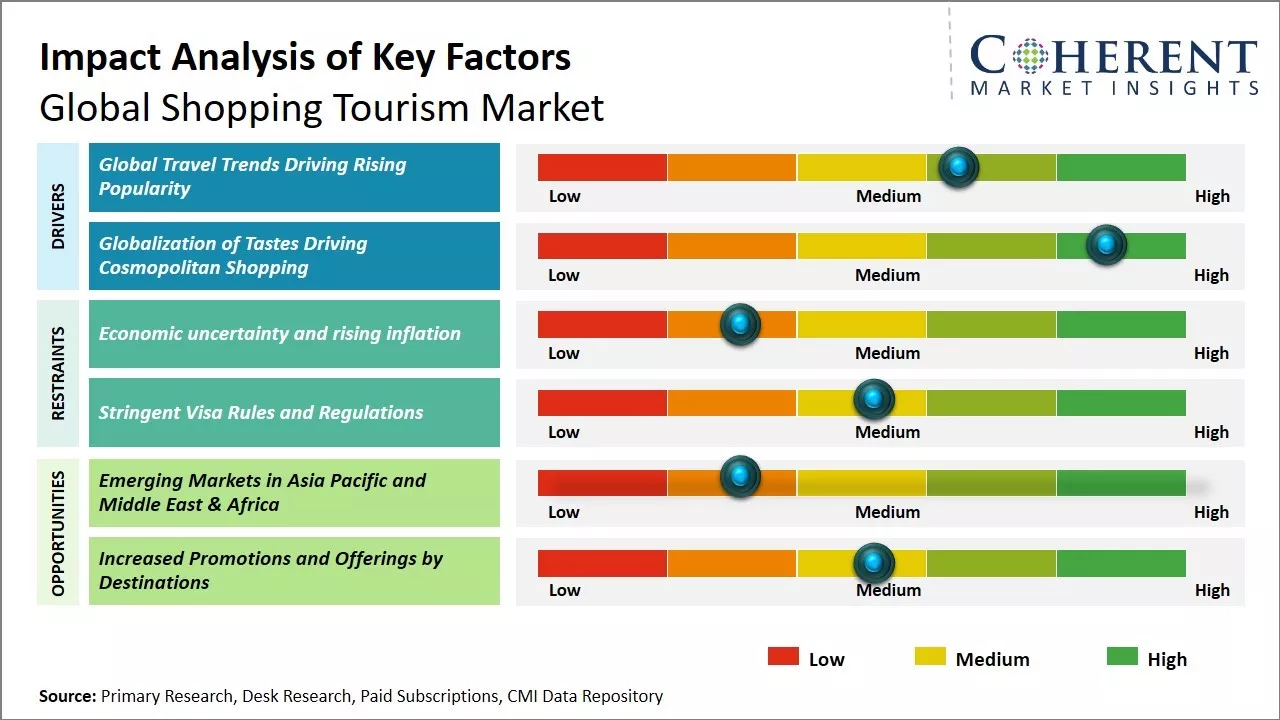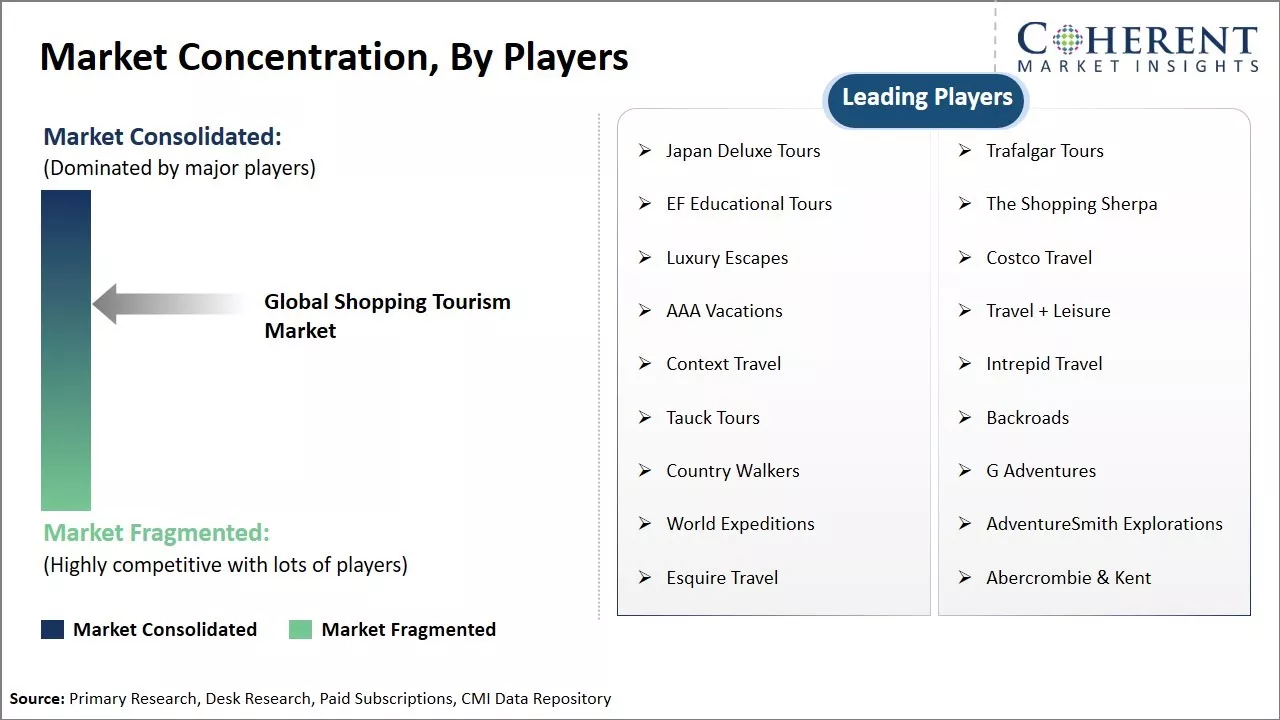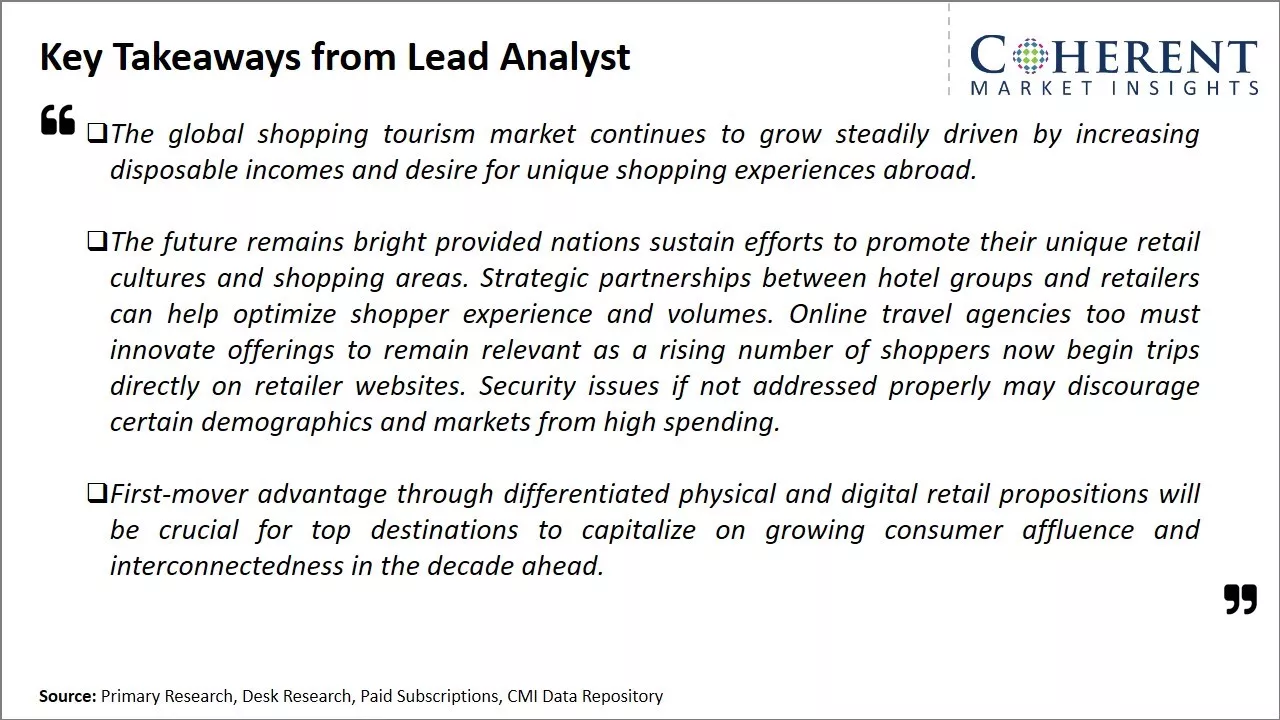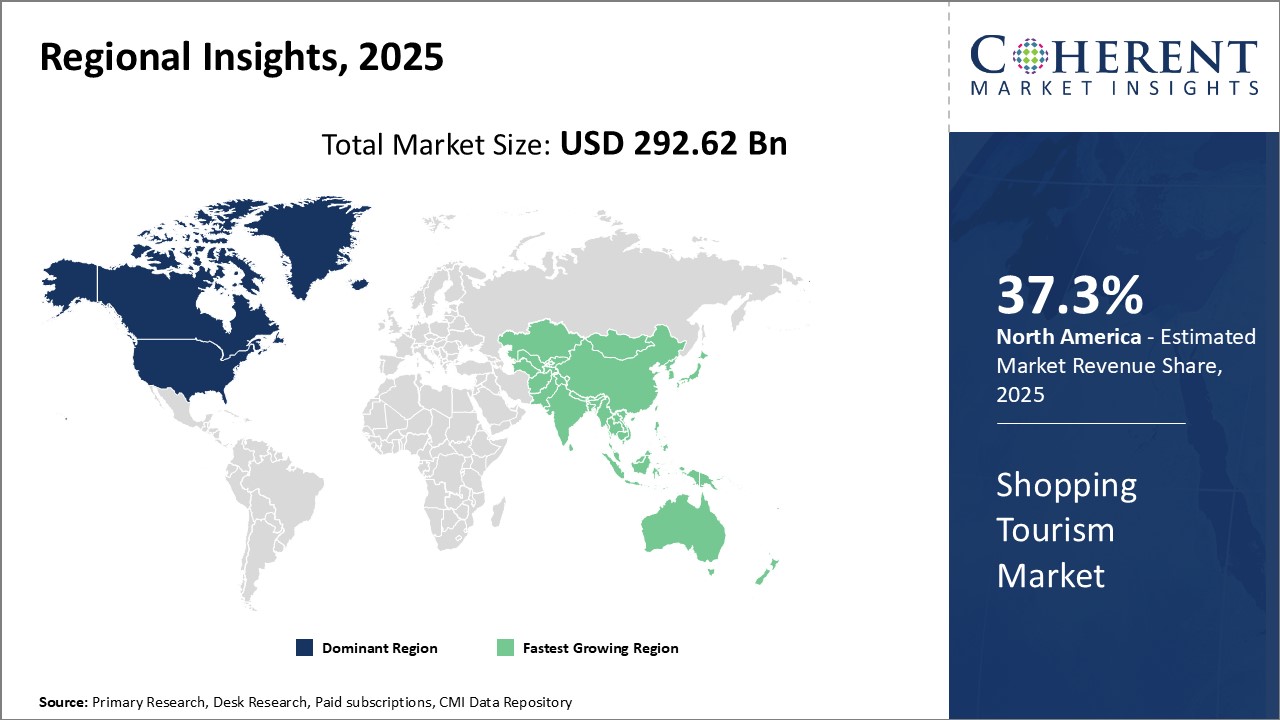Shopping Tourism Market Size and Trends
The Global Shopping Tourism Market is estimated to be valued at USD 292.62 Bn in 2025 and is expected to reach USD 552.69 Bn by 2032, exhibiting a compound annual growth rate (CAGR) of 9.5% from 2025 to 2032.

Discover market dynamics shaping the industry: Download Free Sample
Shopping tourism has seen significant growth over the past decade driven by rising global incomes and expanding middle class populations in emerging markets. Several new destinations have emerged as popular for duty-free shopping and exploring local boutiques. While major cities like Dubai, London, New York, and Paris remain top shopping destinations, smaller cities in Europe and Asia are witnessing sharp rise in foreign tourists who include shopping as part of their itineraries. Consumers are now increasingly interested in unique shopping experiences that are fused with local culture and cuisine. This has encouraged many local businesses and smaller retailers to better promote their products to international visitors.
Global Travel Trends Driving Rising Popularity
The global tourism industry has seen tremendous growth over the past decade, fueled by rising incomes, lower travel costs, and an increasing desire among people to see the world. More and more consumers now view travel not just as a vacation but as a means for learning about new cultures and experiencing new places. This trend of tourism becoming more of a priority is evident in consumer surveys which regularly cite travel and new experiences as important life goals. Major global events like UEFA Euro Cup or FIFA World Cup also encourage tourism with many fans traveling to host cities and countries to attend matches. This growing passion for travel experiences has led to remarkable interest in combining vacation with shopping. Tourists now eagerly seek destinations not just for beaches and landmarks but also to visit buzzing markets, modern shopping malls, and quaint boutique stores. They wish to return home with unique finds and souvenirs that reflect local culture and craft. As tourists gain more exposure to global fashion, food and design through internet and social media, their appetites grow for indulging in these internationally. Cities and regions have recognized the potential of converting tourist arrivals into retail revenues by promoting their distinctive shopping scenes. Carefully planned shopping districts and zones make it easy for visitors to lose themselves in exploration and purchases.
Market Concentration and Competitive Landscape

Get actionable strategies to beat competition: Download Free Sample
Globalization of Tastes Driving Cosmopolitan ShoppingGlobalization has significantly increased the movement of people across borders. With international travel becoming more accessible, people are now exposed to different cultures, cuisines and lifestyles. This widespread cultural interaction and exposure is fueling cosmopolitan tastes among global consumers. They are seeking unique experiences and vibrant multiculturalism beyond what is available locally. This globalization of tastes is a major driver for the growth of global shopping tourism. As consumers travel more, they seek local authentic products that connect them with culture and heritage of their travel destinations. Their shopping excursions have evolved from being a by-product of travel to becoming an experience in itself. Many travel plans are now influenced by the reputation of shopping destinations rather than just attractions or sights. This trend is helping relatively smaller cities and specialist shopping clusters to come up on the global tourism map. For example, medieval towns across Europe known for specialized crafts like glass-making now attract significant tourist shoppers who hunt for distinct regional goods. With the ease of online research, tourists are well informed about unique shopping experiences worldwide before planning their travel. The demand is leading to rapid changes within the retail industries globally as well. Destinations are promoting specialized shopping districts, organizing one-of-kind retail events and craft experiences to make their cities memorable shopping enclaves. Mall developers are increasingly integrating international boutiques, artisanal markets and mixed-use entertainment precincts to appeal varied tourist profiles.

To learn more about this report, Download Free Sample
Challenges: Economic uncertainty and rising inflationThe global shopping tourism market is facing significant restraints in its growth trajectory owing to the widespread economic uncertainty and rising inflation plaguing many economies worldwide. As international travel has resumed post pandemic lockdowns, consumers are growing increasingly cautious in their discretionary spending habits. The conflict in Ukraine and rising energy prices have further exacerbated pre-existing inflationary pressures globally. According to data from the World Bank, consumer price inflation rose to a 40-year high of 8.3% in advanced economies and 9.8% in emerging markets in 2022, reducing consumers' real spending power. Higher costs of living are leaving tourists with diminished budgets to spend on luxury and experiential purchases while traveling. Hefty price increases across all categories from retail goods to international airfares and accommodation are also diminishing the appeal of shopping tourism. Moreover, the uncertain geopolitical environment and risk of recession in major economies have made consumers more cautious about making big ticket purchases. Uncertainty around jobs, incomes and the wider economic outlook have turned shoppers away from non-essential spending. Weaker consumer confidence as a result of high inflation and gloomy economic projections are expected to continue restraining the global shopping tourism industry's growth over the short to medium term. Tourists are prioritizing essential travel and experiences over dedicated shopping trips till macroeconomic conditions stabilize. This will limit opportunities for destinations banking on tourism revenues to revive fully.
Opportunities: Emerging Markets in Asia Pacific and Middle East & Africa
The emerging markets in Asia Pacific and Middle East & Africa regions provide tremendous opportunities to drive growth in the global shopping tourism market going forward. These regions are seeing significant economic and social development which is translating to a burgeoning middle class with higher disposable incomes. International travel from these markets has been on a steady rise according to United Nations World Tourism Organization data. Countries like China, India, Indonesia, Saudi Arabia, United Arab Emirates, etc. have shown strong outbound travel growth from 2014-2019, exceeding global averages. This presents a huge customer base for shopping tourism. As incomes rise, so does the aspiration to travel overseas and make prestigious purchases. Major destinations around the world are ramping up their appeal to these emerging market travelers with targeted visa policies, luxury retail showcasing local crafts and culture, multi-lingual promotions etc. Shopping centers in these regions are also dedicating more space to high-end brands. For instance, Dubai attracts over 20 million visitors annually through its duty-free ports attracting Chinese and Indian customers. Likewise, Bali is working towards becoming a preferred luxury shopping hub in Southeast Asia leveraging its cultural heritage.

Discover high revenue pocket segments and roadmap to it: Download Free Sample
Insights, by Product Type: Fashion ForwardIn terms of Product Type, Fashion & Accessories is estimated to hold 36.2% share in 2025 of the global shopping tourism market owing to people's innate desire to express themselves through what they wear and carry. The fashion industry has always centered on shifting trends that inspire consumers to continually update their wardrobes. Major fashion hubs like Paris, Milan, London and New York influence global styles and beckon tourists seeking the latest looks. Retail meccas stocked full of designer brands fuel people's passion for fashion. Flagship stores become destinations in themselves, pulling in visitors who long to experience the atmosphere of exclusive boutiques. Popular items like handbags, sneakers, jeans and at leisure encourage impulse buys. Tourist’s view shopping as a form of cultural immersion and bringing home coveted accessories feels like a souvenir of taste and status. Celebrity endorsers amplify hype around new collections, driving fashion fanatics to shop where their idols shop. Social media proliferates photos from runway shows and street style, sparking envy and a desire for similar pieces. Influencers with vast followers showcase outfits from trendy neighborhoods, motivating fans to replicate looks on personal trips. The lure of prestige labels and one-of-a-kind boutiques entices spending in this highly image-conscious segment.
Insights, by End User: Shopping Sheroes
In terms of End Users, Women is estimated to hold 53.1% share in 2025 of the global shopping tourism market due to viewing shopping more as a leisure activity and a way to relax. Women tend to be more excited by the browsing and discovery aspects of shopping versus just making practical purchases. They also drive significant spending on beauty, fashion, and home goods. Part of the appeal for women traveling to shop is indulging without everyday responsibilities like family and work. Vacation provides dedicated time for extended shopping excursions with friends in exciting destinations. Women also feel less financial constraints while on shopping trips compared to normal life budgets. This liberates splurging on treats and investment pieces normally too expensive. A girls' getaway centered on shopping creates memorable bonding experiences and photo ops to share. Destination malls and high-end stores cater specifically to women by hosting events, classes and complimentary services. Many tourism boards now even offer "Ladies Who Shop" itineraries and package deals. The social and leisure elements of shopping trips particularly resonate with women.
Insights, by Purpose of Trip: Leisure is the True Driver
Leisure is estimated to hold 36.2% share in 2025, due to people's innate desire to relax and be entertained on vacations. Shopping serves as both a fun activity and souvenir from trips. Unlike business or education travel which involve strict schedules, leisure provides flexibility for impromptu browsing sessions. Many destinations skillfully market themselves as excellent places to simply wander quaint streets and pop in/out of charming boutiques. Cultural attractions that double as opportunities to peruse markets entice free-spirited exploration. Souvenir shops appealingly display local handicrafts and edibles too unique to pass up. Even theme park shareholders understand the value of strategically placed retail zones. For leisure travelers, shopping breaks up boredom between planned activities like sightseeing. Spending a relaxing afternoon sampling cafes and window shopping feels like a mini getaway within a vacation. Stumbling upon a landmark store that becomes a must-visit adds memorable layers to the experience. Shopping preserves treasured moments through keepsakes and inside jokes between travel companions. Ultimately, leisure shopping stimulates both pleasure and nostalgia for trips well spent.
Regional Insights

Need a Different Region or Segment? Download Free Sample
North America has established itself as the dominant region in the global shopping tourism industry with 37.3% share in 2025. With the U.S. being home to some of the largest retail markets in the world, including iconic shopping destinations like New York City and Los Angeles, it attracts millions of domestic and international shoppers each year. American brands like Nike, Coach and Apple have a strong global presence and appeal to shoppers abroad who seek out authentic American products. Major cities across the U.S. and Canada have capitalized on this demand by developing world-class shopping districts and centers that offer visitors an extensive selection of goods at competitive prices. Several shopping centers in the United States such as Mall of America in Minnesota also incorporate entertainment facilities to enhance the overall shopping experience for visitors. Another vital factor contributing to North America's prominence is a robust logistics network that ensures wide product availability and quick delivery times globally. This allows retailers in the region to better cater to shopper demands on an international level. Thus, established retail infrastructure combined with high-profile American brands have made North America the clear leader in the global shopping tourism sector for several years.
Meanwhile, Asia Pacific has emerged as the fastest growing regional market. Countries like Thailand, Singapore, and Malaysia have seen double-digit annual growth in international visitor arrivals for shopping over the past five years. This growth can be attributed to lower costs of goods compared to other developed markets. The region is an attractive destination for shoppers seeking quality products at affordable budget-friendly prices. Additionally, Southeast Asian countries have invested heavily in developing ultra-modern shopping complexes that rival global standards while also reflecting the diverse cultural styles within the region. Free trade zones also allow for easier import and export of goods, improving inventory mixes for retailers. These factors have propelled Southeast Asia to becoming the new bright spot in the global shopping tourism industry.
Market Report Scope
Shopping Tourism Market Report Coverage
| Report Coverage | Details | ||
|---|---|---|---|
| Base Year: | 2024 | Market Size in 2025: | USD 292.62 Bn |
| Historical Data for: | 2020 To 2024 | Forecast Period: | 2025 To 2032 |
| Forecast Period 2025 to 2032 CAGR: | 9.5% | 2032 Value Projection: | USD 552.69 Bn |
| Geographies covered: |
|
||
| Segments covered: |
|
||
| Companies covered: |
Japan Deluxe Tours, Trafalgar Tours, EF Educational Tours, The Shopping Sherpa, Luxury Escapes, Costco Travel, AAA Vacations, Travel + Leisure, Context Travel, Intrepid Travel, Tauck Tours, Backroads, Country Walkers, G Adventures, World Expeditions, AdventureSmith Explorations, Esquire Travel, and Abercrombie & Kent |
||
| Growth Drivers: |
|
||
| Restraints & Challenges: |
|
||
Uncover macros and micros vetted on 75+ parameters: Get instant access to report
Shopping Tourism Industry News
- In February 2024, MakeMyTrip and Goa Government Collaborate for Tourism Revival
- In March 2024, Tourism Authority of Thailand announces inaugural collaboration with Tourism Cares
- In 2023, Risposte Turismo and Enit Join Forces to Promote Shopping Tourism In Italy
- In 2023, Singapore Tourism Board positions itself as shopping destination; three brands feature at Nykaaland
*Definition: The Global Shopping Tourism Market consists of consumers who travel internationally specifically for the purpose of shopping. These shoppers seek out destinations around the world known for their lowest prices on items like clothing, electronics, luxury goods, and more. Countries and cities actively promote themselves as shopping destinations to attract these tourists, who contribute significant revenues to local economies through their spending on retail purchases as well as local amenities like accommodation, dining, entertainment and transportation during their visit.
Market Segmentation
- Product Type Insights (Revenue, USD Bn, 2020 - 2032)
- Fashion & Accessories
- Beauty & Cosmetics
- Electronics
- Food & Beverage
- Others
- End User Insights (Revenue, USD Bn, 2020 - 2032)
- Men
- Women
- Others
- Purpose of Trip Insights (Revenue, USD Bn, 2020 - 2032)
- Leisure
- Medical
- Business
- Education
- Regional Insights (Revenue, USD Bn, 2020 - 2032)
- North America
- U.S.
- Canada
- Latin America
- Brazil
- Argentina
- Mexico
- Rest of Latin America
- Europe
- Germany
- U.K.
- Spain
- France
- Italy
- Russia
- Rest of Europe
- Asia Pacific
- China
- India
- Japan
- Australia
- South Korea
- ASEAN
- Rest of Asia Pacific
- Middle East & Africa
- GCC Countries
- Israel
- Rest of Middle East & Africa
- North America
- Key Players Insights
- Japan Deluxe Tours
- Trafalgar Tours
- EF Educational Tours
- The Shopping Sherpa
- Luxury Escapes
- Costco Travel
- AAA Vacations
- Travel + Leisure
- Context Travel
- Intrepid Travel
- Tauck Tours
- Backroads
- Country Walkers
- G Adventures
- World Expeditions
- AdventureSmith Explorations
- Esquire Travel
- Abercrombie & Kent
Share
Share
About Author
Yash Doshi is a Senior Management Consultant. He has 12+ years of experience in conducting research and handling consulting projects across verticals in APAC, EMEA, and the Americas.
He brings strong acumen in helping chemical companies navigate complex challenges and identify growth opportunities. He has deep expertise across the chemicals value chain, including commodity, specialty and fine chemicals, plastics and polymers, and petrochemicals. Yash is a sought-after speaker at industry conferences and contributes to various publications on topics related commodity, specialty and fine chemicals, plastics and polymers, and petrochemicals.
Missing comfort of reading report in your local language? Find your preferred language :
Transform your Strategy with Exclusive Trending Reports :
Frequently Asked Questions
EXISTING CLIENTELE
Joining thousands of companies around the world committed to making the Excellent Business Solutions.
View All Our Clients
